лекция по гласным.ppt
- Количество слайдов: 16
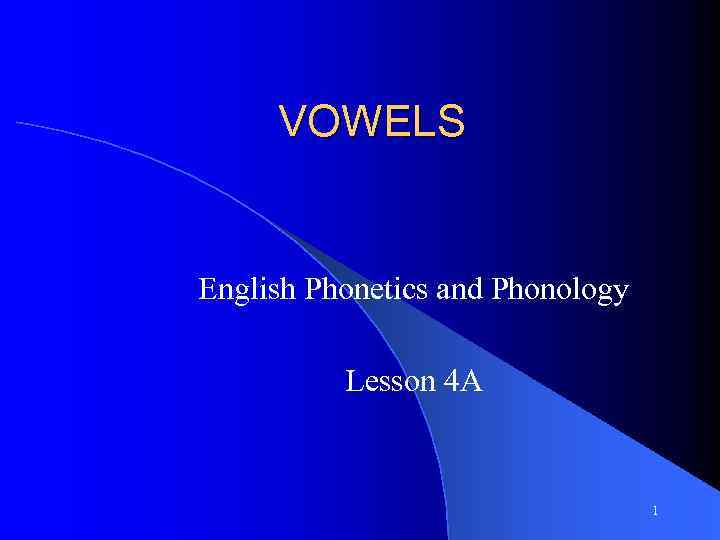 VOWELS English Phonetics and Phonology Lesson 4 A 1
VOWELS English Phonetics and Phonology Lesson 4 A 1
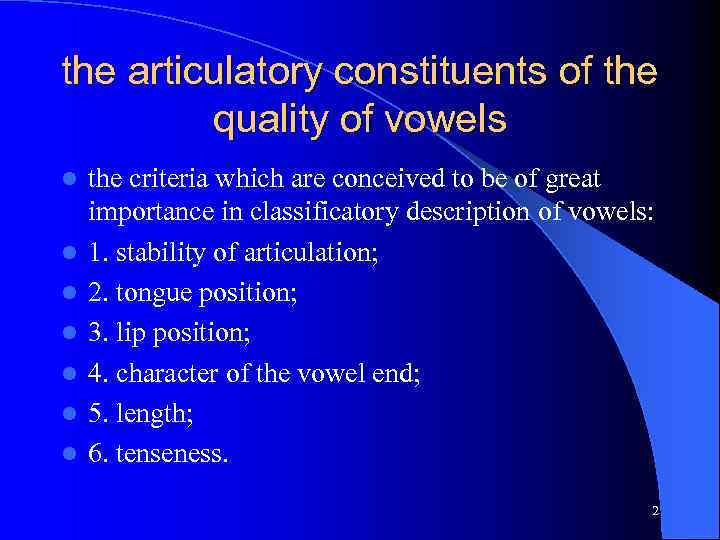 the articulatory constituents of the quality of vowels l l l l the criteria which are conceived to be of great importance in classificatory description of vowels: 1. stability of articulation; 2. tongue position; 3. lip position; 4. character of the vowel end; 5. length; 6. tenseness. 2
the articulatory constituents of the quality of vowels l l l l the criteria which are conceived to be of great importance in classificatory description of vowels: 1. stability of articulation; 2. tongue position; 3. lip position; 4. character of the vowel end; 5. length; 6. tenseness. 2
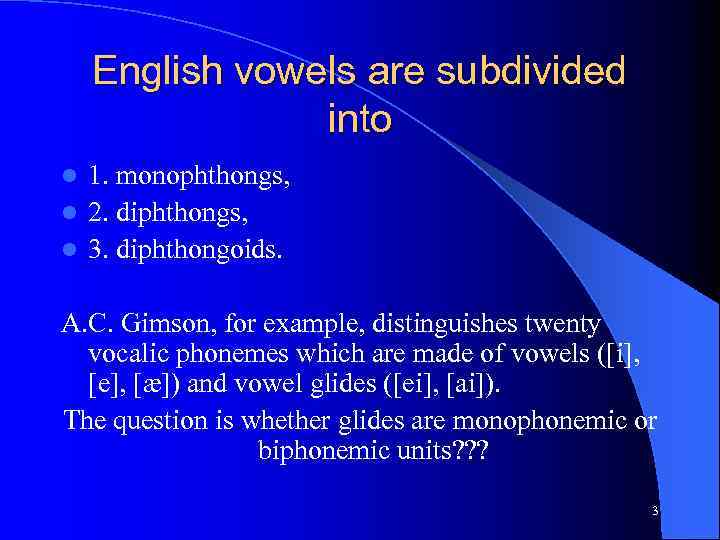 English vowels are subdivided into 1. monophthongs, l 2. diphthongs, l 3. diphthongoids. l A. C. Gimson, for example, distinguishes twenty vocalic phonemes which are made of vowels ([i], [e], [æ]) and vowel glides ([ei], [ai]). The question is whether glides are monophonemic or biphonemic units? ? ? 3
English vowels are subdivided into 1. monophthongs, l 2. diphthongs, l 3. diphthongoids. l A. C. Gimson, for example, distinguishes twenty vocalic phonemes which are made of vowels ([i], [e], [æ]) and vowel glides ([ei], [ai]). The question is whether glides are monophonemic or biphonemic units? ? ? 3
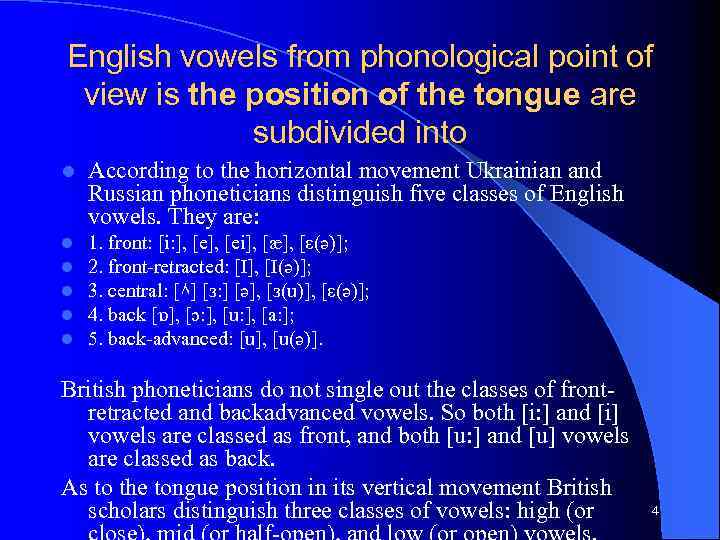 English vowels from phonological point of view is the position of the tongue are subdivided into l According to the horizontal movement Ukrainian and Russian phoneticians distinguish five classes of English vowels. They are: l l l 1. front: [i: ], [ei], [æ], [ε(ə)]; 2. front-retracted: [I], [I(ə)]; 3. central: [٨] [з: ] [ə], [з(u)], [ε(ə)]; 4. back [ɒ], [ɔ: ], [u: ], [a: ]; 5. back-advanced: [u], [u(ə)]. British phoneticians do not single out the classes of frontretracted and backadvanced vowels. So both [i: ] and [i] vowels are classed as front, and both [u: ] and [u] vowels are classed as back. As to the tongue position in its vertical movement British scholars distinguish three classes of vowels: high (or 4
English vowels from phonological point of view is the position of the tongue are subdivided into l According to the horizontal movement Ukrainian and Russian phoneticians distinguish five classes of English vowels. They are: l l l 1. front: [i: ], [ei], [æ], [ε(ə)]; 2. front-retracted: [I], [I(ə)]; 3. central: [٨] [з: ] [ə], [з(u)], [ε(ə)]; 4. back [ɒ], [ɔ: ], [u: ], [a: ]; 5. back-advanced: [u], [u(ə)]. British phoneticians do not single out the classes of frontretracted and backadvanced vowels. So both [i: ] and [i] vowels are classed as front, and both [u: ] and [u] vowels are classed as back. As to the tongue position in its vertical movement British scholars distinguish three classes of vowels: high (or 4
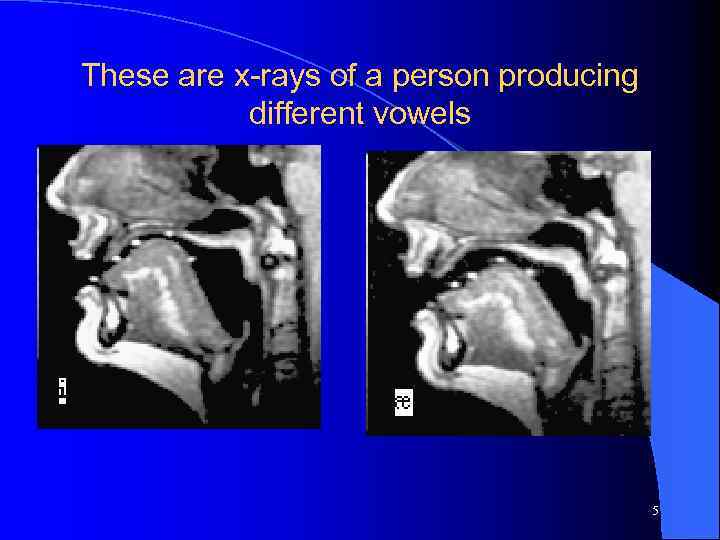 These are x-rays of a person producing different vowels 5
These are x-rays of a person producing different vowels 5
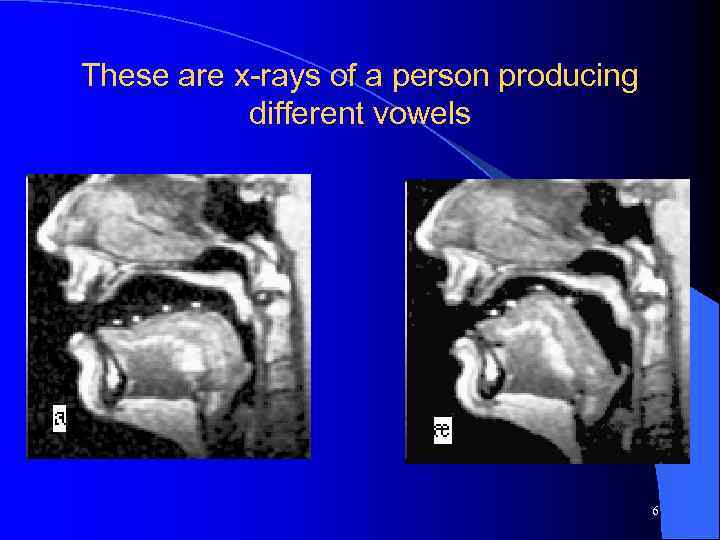 These are x-rays of a person producing different vowels 6
These are x-rays of a person producing different vowels 6
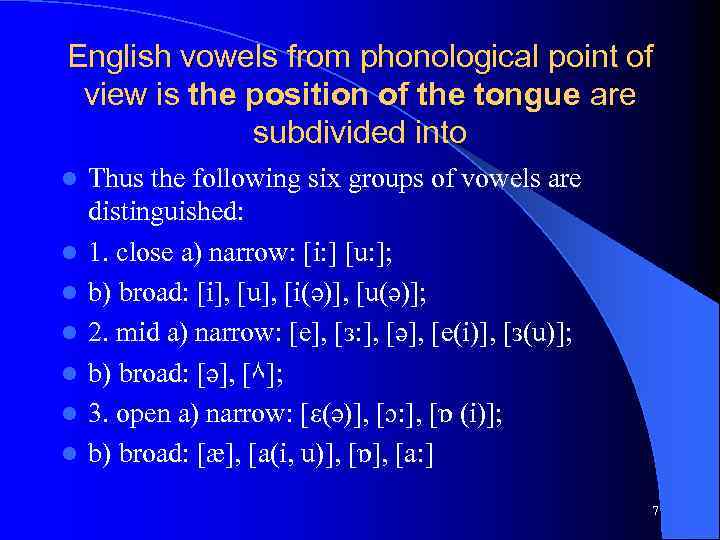 English vowels from phonological point of view is the position of the tongue are subdivided into l l l l Thus the following six groups of vowels are distinguished: 1. close a) narrow: [i: ] [u: ]; b) broad: [i], [u], [i(ə)], [u(ə)]; 2. mid a) narrow: [e], [з: ], [ə], [e(i)], [з(u)]; b) broad: [ə], [٨]; 3. open a) narrow: [ε(ə)], [ɔ: ], [ɒ (i)]; b) broad: [æ], [a(i, u)], [ɒ], [a: ] 7
English vowels from phonological point of view is the position of the tongue are subdivided into l l l l Thus the following six groups of vowels are distinguished: 1. close a) narrow: [i: ] [u: ]; b) broad: [i], [u], [i(ə)], [u(ə)]; 2. mid a) narrow: [e], [з: ], [ə], [e(i)], [з(u)]; b) broad: [ə], [٨]; 3. open a) narrow: [ε(ə)], [ɔ: ], [ɒ (i)]; b) broad: [æ], [a(i, u)], [ɒ], [a: ] 7
 Here is the vowel quadrilateral divided into sectors with the IPA symbols at fixed points. These are called Cardinal Vowels. 8
Here is the vowel quadrilateral divided into sectors with the IPA symbols at fixed points. These are called Cardinal Vowels. 8
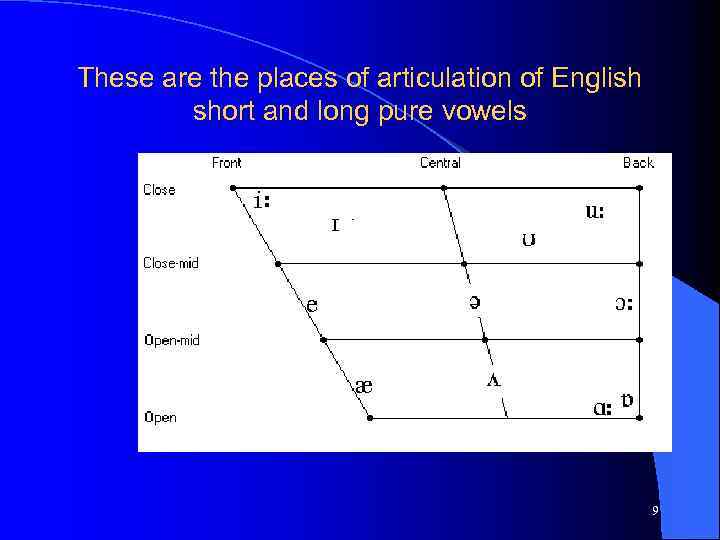 These are the places of articulation of English short and long pure vowels 9
These are the places of articulation of English short and long pure vowels 9
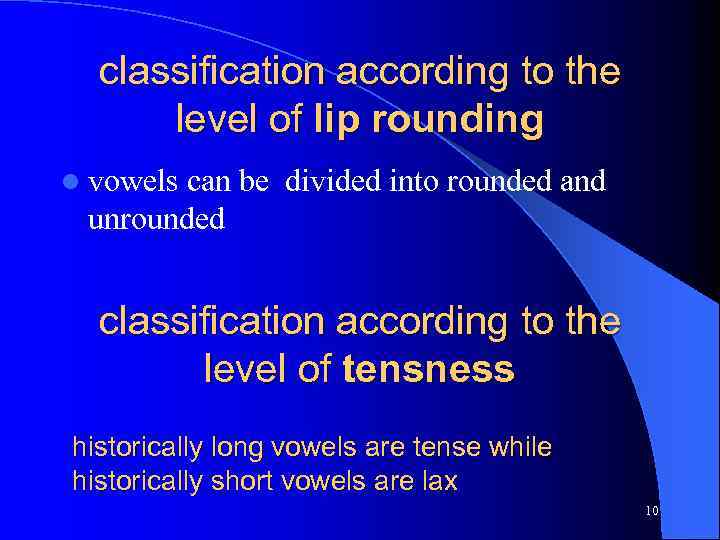 classification according to the level of lip rounding l vowels can be divided into rounded and unrounded classification according to the level of tensness historically long vowels are tense while historically short vowels are lax 10
classification according to the level of lip rounding l vowels can be divided into rounded and unrounded classification according to the level of tensness historically long vowels are tense while historically short vowels are lax 10
![The English monophthongs l l a) short vowels: [i], [e], [æ], [ɒ], [u], [٨], The English monophthongs l l a) short vowels: [i], [e], [æ], [ɒ], [u], [٨],](https://present5.com/presentation/3/88179711_132939828.pdf-img/88179711_132939828.pdf-11.jpg) The English monophthongs l l a) short vowels: [i], [e], [æ], [ɒ], [u], [٨], [ə]; b) long vowels: [i: ], [a: ], [ɔ: ], [з: ], [u: ]. l Duration is one of the characteristics of a vowel which is modified by and depends on the following factors: 1. its own length, 2. the accent of the syllable in which it occurs, 3. phonetic context, 4. the position of the sound in a syllable, 5. the position in a rhythmic structure, 6. the position in a tone group, 7. the position in a phrase, 8. the position in an utterance, 9. the tempo of the whole utterance, 10. the type of pronunciation, 11. the style of pronunciation. 11 l l l l
The English monophthongs l l a) short vowels: [i], [e], [æ], [ɒ], [u], [٨], [ə]; b) long vowels: [i: ], [a: ], [ɔ: ], [з: ], [u: ]. l Duration is one of the characteristics of a vowel which is modified by and depends on the following factors: 1. its own length, 2. the accent of the syllable in which it occurs, 3. phonetic context, 4. the position of the sound in a syllable, 5. the position in a rhythmic structure, 6. the position in a tone group, 7. the position in a phrase, 8. the position in an utterance, 9. the tempo of the whole utterance, 10. the type of pronunciation, 11. the style of pronunciation. 11 l l l l
![the phonemic status of the neutral sound [ə] In English there are numerous alternations the phonemic status of the neutral sound [ə] In English there are numerous alternations](https://present5.com/presentation/3/88179711_132939828.pdf-img/88179711_132939828.pdf-12.jpg) the phonemic status of the neutral sound [ə] In English there are numerous alternations of vowels in stressed and unstressed syllables between the derivatives of the same root or different grammatical forms of the same word. Cf. : l [æ] – [ə] man – sportsman l [٨] – [ə] some – wholesome l [ɒ] – [ə] combine n – combine v l [ei] – [ə] operation – operative l [зu] – [ə] post – postpone Nearly one sound in five is either [ə] or the unstressed [i]. This high frequency of [ə] is the result of the rhythmic pattern: if unstressed syllables are given only a short duration , the vowel in them which might be otherwise full is reduced. 12 l
the phonemic status of the neutral sound [ə] In English there are numerous alternations of vowels in stressed and unstressed syllables between the derivatives of the same root or different grammatical forms of the same word. Cf. : l [æ] – [ə] man – sportsman l [٨] – [ə] some – wholesome l [ɒ] – [ə] combine n – combine v l [ei] – [ə] operation – operative l [зu] – [ə] post – postpone Nearly one sound in five is either [ə] or the unstressed [i]. This high frequency of [ə] is the result of the rhythmic pattern: if unstressed syllables are given only a short duration , the vowel in them which might be otherwise full is reduced. 12 l
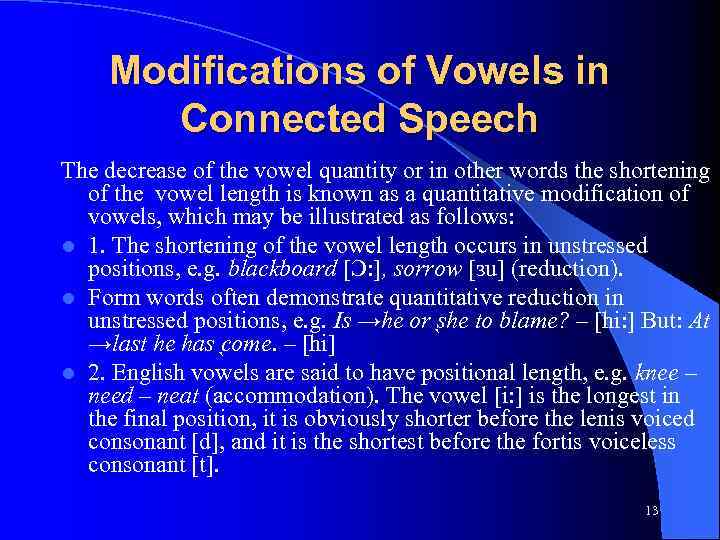 Modifications of Vowels in Connected Speech The decrease of the vowel quantity or in other words the shortening of the vowel length is known as a quantitative modification of vowels, which may be illustrated as follows: l 1. The shortening of the vowel length occurs in unstressed positions, e. g. blackboard [Ɔ: ], sorrow [зu] (reduction). l Form words often demonstrate quantitative reduction in unstressed positions, e. g. Is →he or she to blame? – [hi: ] But: At →last he has come. – [hi] l 2. English vowels are said to have positional length, e. g. knee – need – neat (accommodation). The vowel [i: ] is the longest in the final position, it is obviously shorter before the lenis voiced consonant [d], and it is the shortest before the fortis voiceless consonant [t]. 13
Modifications of Vowels in Connected Speech The decrease of the vowel quantity or in other words the shortening of the vowel length is known as a quantitative modification of vowels, which may be illustrated as follows: l 1. The shortening of the vowel length occurs in unstressed positions, e. g. blackboard [Ɔ: ], sorrow [зu] (reduction). l Form words often demonstrate quantitative reduction in unstressed positions, e. g. Is →he or she to blame? – [hi: ] But: At →last he has come. – [hi] l 2. English vowels are said to have positional length, e. g. knee – need – neat (accommodation). The vowel [i: ] is the longest in the final position, it is obviously shorter before the lenis voiced consonant [d], and it is the shortest before the fortis voiceless consonant [t]. 13
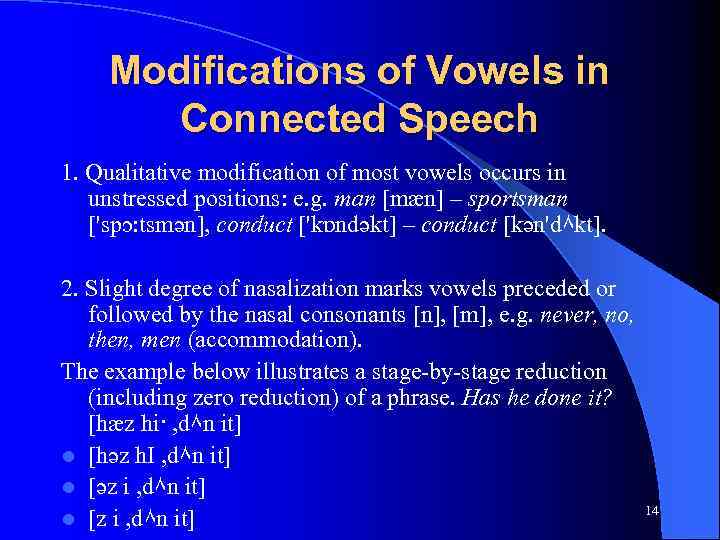 Modifications of Vowels in Connected Speech 1. Qualitative modification of most vowels occurs in unstressed positions: e. g. man [mæn] – sportsman ['spɔ: tsmən], conduct ['kɒndəkt] – conduct [kən'd٨kt]. 2. Slight degree of nasalization marks vowels preceded or followed by the nasal consonants [n], [m], e. g. never, no, then, men (accommodation). The example below illustrates a stage-by-stage reduction (including zero reduction) of a phrase. Has he done it? [hæz hi· , d٨n it] l [həz h. I , d٨n it] l [əz i , d٨n it] l [z i , d٨n it] 14
Modifications of Vowels in Connected Speech 1. Qualitative modification of most vowels occurs in unstressed positions: e. g. man [mæn] – sportsman ['spɔ: tsmən], conduct ['kɒndəkt] – conduct [kən'd٨kt]. 2. Slight degree of nasalization marks vowels preceded or followed by the nasal consonants [n], [m], e. g. never, no, then, men (accommodation). The example below illustrates a stage-by-stage reduction (including zero reduction) of a phrase. Has he done it? [hæz hi· , d٨n it] l [həz h. I , d٨n it] l [əz i , d٨n it] l [z i , d٨n it] 14
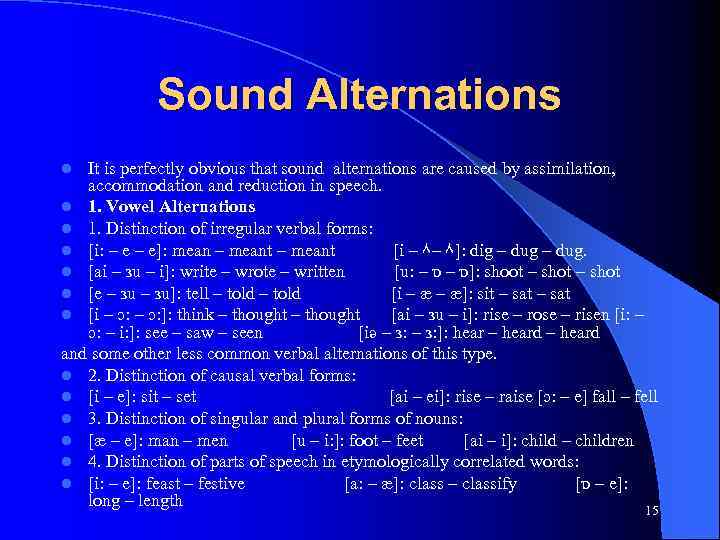 Sound Alternations It is perfectly obvious that sound alternations are caused by assimilation, accommodation and reduction in speech. l 1. Vowel Alternations l 1. Distinction of irregular verbal forms: l [i: – e]: mean – meant [i – ٨– ٨]: dig – dug. l [ai – зu – i]: write – wrote – written [u: – ɒ]: shoot – shot l [e – зu]: tell – told [i – æ]: sit – sat l [i – ɔ: ]: think – thought [ai – зu – i]: rise – rose – risen [i: – ɔ: – i: ]: see – saw – seen [iə – з: ]: hear – heard and some other less common verbal alternations of this type. l 2. Distinction of causal verbal forms: l [i – e]: sit – set [ai – ei]: rise – raise [ɔ: – e] fall – fell l 3. Distinction of singular and plural forms of nouns: l [æ – e]: man – men [u – i: ]: foot – feet [ai – i]: child – children l 4. Distinction of parts of speech in etymologically correlated words: l [i: – e]: feast – festive [a: – æ]: class – classify [ɒ – e]: long – length 15 l
Sound Alternations It is perfectly obvious that sound alternations are caused by assimilation, accommodation and reduction in speech. l 1. Vowel Alternations l 1. Distinction of irregular verbal forms: l [i: – e]: mean – meant [i – ٨– ٨]: dig – dug. l [ai – зu – i]: write – wrote – written [u: – ɒ]: shoot – shot l [e – зu]: tell – told [i – æ]: sit – sat l [i – ɔ: ]: think – thought [ai – зu – i]: rise – rose – risen [i: – ɔ: – i: ]: see – saw – seen [iə – з: ]: hear – heard and some other less common verbal alternations of this type. l 2. Distinction of causal verbal forms: l [i – e]: sit – set [ai – ei]: rise – raise [ɔ: – e] fall – fell l 3. Distinction of singular and plural forms of nouns: l [æ – e]: man – men [u – i: ]: foot – feet [ai – i]: child – children l 4. Distinction of parts of speech in etymologically correlated words: l [i: – e]: feast – festive [a: – æ]: class – classify [ɒ – e]: long – length 15 l
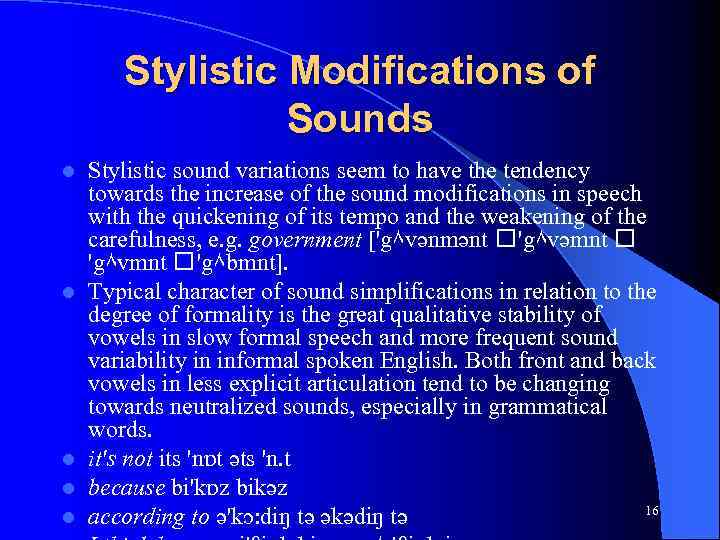 Stylistic Modifications of Sounds l l l Stylistic sound variations seem to have the tendency towards the increase of the sound modifications in speech with the quickening of its tempo and the weakening of the carefulness, e. g. government ['g٨vənmənt 'g٨vəmnt 'g٨vmnt 'g٨bmnt]. Typical character of sound simplifications in relation to the degree of formality is the great qualitative stability of vowels in slow formal speech and more frequent sound variability in informal spoken English. Both front and back vowels in less explicit articulation tend to be changing towards neutralized sounds, especially in grammatical words. it's not its 'nɒt əts 'n. t because bi'kɒz bikəz 16 according to ə'kɔ: diŋ tə əkədiŋ tə
Stylistic Modifications of Sounds l l l Stylistic sound variations seem to have the tendency towards the increase of the sound modifications in speech with the quickening of its tempo and the weakening of the carefulness, e. g. government ['g٨vənmənt 'g٨vəmnt 'g٨vmnt 'g٨bmnt]. Typical character of sound simplifications in relation to the degree of formality is the great qualitative stability of vowels in slow formal speech and more frequent sound variability in informal spoken English. Both front and back vowels in less explicit articulation tend to be changing towards neutralized sounds, especially in grammatical words. it's not its 'nɒt əts 'n. t because bi'kɒz bikəz 16 according to ə'kɔ: diŋ tə əkədiŋ tə


